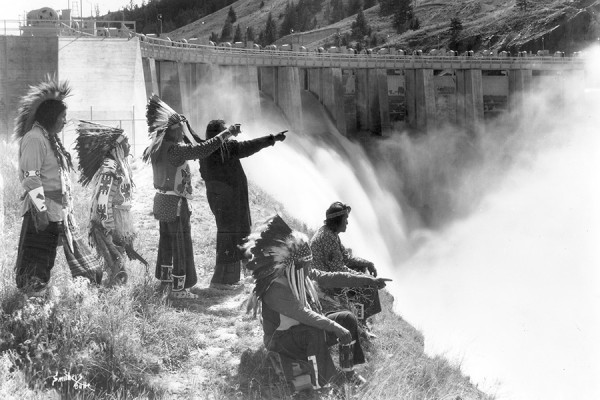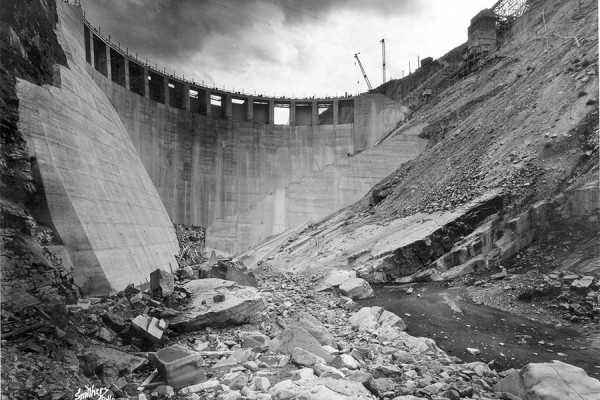POLSON – Five miles below the southern shores of Flathead Lake, wedged between a rugged river canyon where a great waterfall once roared, Kerr Dam plays a prominent role in the landscape.
Blockading the Flathead River behind a 200-foot concrete arch, the 194-megawatt plant produces an average of 1.1 million megawatt-hours of electricity per year, enough to power more than 100,000 homes annually. It can generate up to $60 million a year on the wholesale market in the West, depending on energy prices. It can also regulate the shore levels of the largest freshwater lake west of the Mississippi while at the same time feeding 13 different reservoirs that provide vital irrigation supplies to the area’s farmers, ranchers and other property owners.
Yet alongside its power and influence, Kerr Dam has remained equally contentious and divisive among tribal members and non-Indian property owners trying to coexist amicably on the Flathead Indian Reservation while grappling over water rights.
Nearly 80 years since the dam was developed, creating a significant domino effect of impacts that are still felt today, the controversial subject is approaching a tipping point.
While the Montana Legislature prepares to revisit one of the most controversial subjects in recent memory — a water-rights compact for the Flathead Reservation — the Confederated Salish and Kootenai Tribes are preparing to take over Kerr Dam.
Both events are being met with scrutiny, and both are equally significant.
The CSKT have remained devoted to acquiring the dam for decades, and one year from now — Sept. 5, 2015 — that mission will finally come to fruition. The CSKT are slated to pay nearly $18.3 million for the facility, which will be operated through a tribally owned corporation known as Energy Keepers, Inc.

For the roughly 5,000 tribal members living on the reservation, the deal will represent a milestone. The CSKT, which was formed in direct response to the development of Kerr Dam and became the nation’s first tribal government with a federally recognized constitution, will now become the first tribal government in the U.S. to own a major hydroelectric facility. It will also mark the successful reclamation of a section of land that holds great meaning.
“The first thing we should always start with when we talk about Kerr Dam is that it’s parked in the middle of our reservation,” said Brian Lipscomb, a CSKT member and CEO of Energy Keepers. “And it’s a very significant site to us as a tribal people. This is a religious site. It’s a cultural site. It always has been. It always will be.”
But others, such as Republican State Rep. Verdell Jackson, who represents House District 6 in and around Kalispell, see the deal in a different light and describe it as part of a power grab that could worsen an already bitter battle over water rights within the reservation.
“If the tribe gets what they are trying to get with the water compact or the dam or the lawsuits, they will control all the water in western Montana,” Jackson said. “Of course they also want to take private property away from non-Indians on the reservation. They want to take away their water rights and their property. And because they say they’re a separate nation, they don’t have to follow state laws.”
An age-old dispute over who controls the water and how much is allocated throughout the reservation will reach the forefront once again this winter when the Montana Legislature convenes in Helena. State lawmakers will decide whether to approve the latest version of the Flathead water compact, a complex document that outlines who controls water flowing in and out of the reservation. The CSKT, which filed multiple lawsuits over claims to the water earlier this year, proposed a compact to the state in 2013. But the Legislature rejected the deal, sparking uncertainty over present and future water claims across western Montana.
The latest version that’s likely to be proposed during the upcoming winter session appears no less divisive.
“Half of my constituents are lobbying me hard in favor of it and half are lobbying hard against it. This is the most controversial and divisive issue I’ve seen in my time serving,” said Janna Taylor, a Republican from Dayton serving Senate District 6.

The tribes have also historically focused on acquiring tribal land within the reservation that was designated by Congress in 1872 by buying back parcels that were sold to homesteaders in the early 20th century.
At one point in the 1930s, following the U.S. government’s attempt to spur development and settlement in Indian Country, the Flathead Reservation was only 20 percent owned by CSKT members. Now the tribes’ have “reacquired” nearly 70 percent of the reservation, according to Lipscomb.
“We’ve always been aggressive about taking back our own resources,” he said.
Lloyd Irvine, a CSKT tribal councilman and longtime advocate for protecting the tribes’ cultural heritage, described the acquisition of tribal lands and Kerr Dam as essential to protecting the reservation from being dissolved over time.
“On a day-to-day basis, we have to fight to protect what we have,” Irvine said. “Getting back Kerr Dam is part of our vision. And we’ve been working on this for a long time.”
He added, “There are a lot of people who think Indians just shouldn’t be in charge of anything.”
Lipscomb and other tribal leaders dispute Jackson’s claims that the tribes will have free rein to dry up irrigators or drastically change the operation of Kerr Dam.
“People are making assertions that are simply not based in fact,” Lipscomb said.
When the CSKT acquire Kerr Dam, the tribes will acquire the identical license that regulated PPL Montana, the dam’s current operator. PPL Montana, which is based in Pennsylvania, is planning to sell 11 dams in Montana, including Kerr, to NorthWestern Energy and NorthWestern has already agreed to transfer Kerr to the CSKT in the fall of 2015.
The Kerr license, which is documented on the Energy Keepers’ website, shows the rules and regulations that the CSKT will have to follow under the Federal Energy Regulatory Commission. Those regulations include flow restrictions for the river, flood control standards, drought management standards and fish and wildlife habitat standards.
“It’s right there all in writing,” Lipscomb said. “To change that license with FERC would require a very public process. If the tribes ever intend to change anything, it will be with an open public process.”
The current license is set to expire in 2035, at which point a new license will have to be issued.
Celeste Miller with FERC confirmed that when a license is transferred from one entity to another, the new operator or holder is responsible for complying with all terms and conditions of that license.
Miller also confirmed that if the CSKT were to ever propose an amendment to the license, it would require an extensive public vetting through FERC.
Another concern, raised by Lake County commissioners, is the loss of tax revenue once the tribes acquire Kerr Dam. Last year PPL Montana paid $978,179 in property taxes to Lake County, according to tax statements obtained by the Beacon. Of those funds, $619,847 supported schools and $292,080 supported county services.
“There is concern that a piece of tax base will go away,” Lipscomb acknowledged. “There’s concern that the tribes won’t pay taxes so that revenue will be lost for local government and schools. Well the tribes don’t operate that way.”
Lipscomb said the CSKT tribal council is reviewing options to replace the lost tax revenues, including potentially payment in lieu of taxes or another form of reimbursement.
“We’re trying to get all of that assessed,” Lipscomb said. “Obviously we benefit from those services as well. We have kids in the schools. We drive on the county roads.”
Yet Jackson remains skeptical. He said he does not believe the CSKT intend to meet the FERC license conditions. He also worries that the tribes won’t honor historic water deliveries to irrigators, particularly as the water rights compact approaches a boiling point. Jackson said a large portion of his constituents have voiced their worries, too.
“Our collective experience with the Confederated Salish and Kootenai Tribes suggests that if the recommended conditions are not in writing, they will not be done. Verbal commitments made now will not necessarily be adhered to in the future,” Jackson wrote to FERC in a motion to intervene in the transfer of the Kerr license. According to officials, FERC received Jackson’s motion and is reviewing it to determine whether further review of the upcoming acquisition is necessary.

Meanwhile, Lipscomb and the CSKT are moving forward, counting down the days until Sept. 5 of next year. For the last two years, tribal employees have been shadowing PPL workers to learn the intricacies of operating the dam. Sixty-five people applied to work at the facility, Lipscomb said, and the tribes plan to hire a staff of 21 people to manage and operate all aspects of the dam. So far, 11 of the 18 employees on staff are tribal members.
The employees will work for Energy Keepers, which is a separate corporation under the oversight of the tribes, similar to S&K Technologies and other prominent CSKT commercial entities.
Energy Keepers will provide direct support to the tribes, Lipscomb said. Since the dam was built on tribal land, the operators, such as PPL, have paid rent to the tribes on an annual basis. Last year PPL paid $19 million in land-use fees to the CSKT, which depends on the major revenue source. Energy Keepers similarly will pay the tribal government through revenues, Lipscomb said.
The tribal council is also planning to rename the facility, and the new title will likely be unveiled near the acquisition date.
“This is the recapturing of a pretty significant place for us, from a cultural and religious perspective, and it will mean the management of our own resources,” said Lipscomb.
“We’re getting back the resources that were preserved for us by our forefathers and by our chiefs in 1855 when they signed (the Hellgate Treaty). It will be a great accomplishment from our perspective and allow us to provide that for our future generations.”
